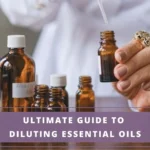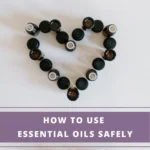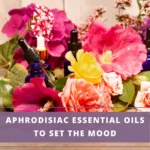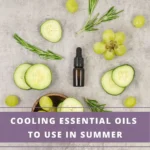As an Amazon Associate I earn from qualifying purchases. See Full Disclosure Here
In the world of plant-based oils, there is often confusion surrounding essential oils vs. carrier oils. Both types of oils offer numerous benefits for health, wellness, and skincare, but understanding their unique properties and uses is crucial. Most important is understanding the difference between essential oils and carrier oils
In this comprehensive guide that compares essential oils vs. carrier oils, I delve deep into the differences between the two in terms of their extraction methods, benefits, and how they can be effectively combined for maximum results.
What are Essential Oils?
 Essential oils are highly concentrated and volatile aromatic compounds extracted from various plant materials. The source material may include flowers, seeds, roots, leaves, fruit, herbs, or bark depending on the plant species.
Essential oils are highly concentrated and volatile aromatic compounds extracted from various plant materials. The source material may include flowers, seeds, roots, leaves, fruit, herbs, or bark depending on the plant species.
These concentrated extracts capture the true essence of the plant, hence their name. Each oil carries the unique, characteristic scent, properties, and benefits of its source materials. Essential oils are well-known for their therapeutic properties.
How Essential Oils Are Extracted
The extraction process for essential oils is critically important, as it must be done using a non-chemical method to produce a true essential oil.
The most common extraction methods include:
Steam Distillation: This process involves using heat and water to release the volatile oils from the plant material. The steam is then condensed back into a liquid using cold water, and the essential oil is separated from the remaining liquid.
Cold Pressing: Typically used for essential oils extracted from citrus fruit peels, this method involves mechanically pressing the plant material to release the volatile oils.
Read more: What are Essential Oils?
What are Carrier Oils?
 Carrier oils, also known as base oils or fixed oils, are natural oils derived from the fatty parts of plants, such as seeds, nuts, or kernels. They are called “carrier” oils because they are used to dilute essential oils and carry them safely onto the skin when applied.
Carrier oils, also known as base oils or fixed oils, are natural oils derived from the fatty parts of plants, such as seeds, nuts, or kernels. They are called “carrier” oils because they are used to dilute essential oils and carry them safely onto the skin when applied.
Unlike essential oils, carrier oils are not volatile or concentrated. They are rich in vitamins, minerals, and fatty acids that nourish, moisturize, and hydrate the skin, making them ideal for skincare applications.
How Carrier Oils Are Extracted
The most common extraction method for carrier oils is cold pressing, which involves mechanically pressing the plant material to release the oil. This process helps preserve the beneficial properties of the carrier oil, ensuring its effectiveness in skincare and wellness applications.
Read: What are Carrier Oils for Essential Oils
Key Differences Between Essential Oils and Carrier Oils
 While both essential oils and carrier oils are derived from plants and offer numerous benefits, their properties, uses, and extraction methods differ significantly.
While both essential oils and carrier oils are derived from plants and offer numerous benefits, their properties, uses, and extraction methods differ significantly.
Properties
Essential oils are highly aromatic and concentrated. They contain a very high percentage of the beneficial compounds contained in the original plant part. Essential oils are also very volatile and evaporate quickly.
Carrier oils may be odorless or have a mild, neutral aroma. They are less concentrated and do not evaporate quickly. Carrier oils contain nourishing vitamins, minerals, and fatty acids. They serve as an excellent medium to dilute essential oils for topical applications.
Uses
Essential oils offer unique therapeutic properties and aromatherapy benefits, making them popular for use in diffusers, massages, and skincare products.
Carrier oils are primarily used to dilute essential oils for safe topical application, but they can also be used on their own as a moisturizer or in combination with other oils in skincare formulations.
Benefits
Essential oils are valued for their wide range of therapeutic benefits, including relaxation, pain relief, and immune support.
Carrier oils offer outstanding hydrating, moisturizing, and nourishing properties for skin and hair.
Application
Essential oils can be used on their own only in diffusers. Due to their concentrated nature, they must be diluted with a carrier oil before application to the skin. They must be used in tiny quantities to prevent any adverse effects.
Carrier oils can be applied to the skin on their own or with essential oils for massages or as moisturizers. They can be used more liberally without any adverse side effects.
Extraction Methods
Essential oils are typically extracted through steam distillation or cold pressing, depending on the plant material used.
Carrier oils are most commonly extracted through cold pressing, preserving their beneficial properties.
Which Oils Are Essential Oils?
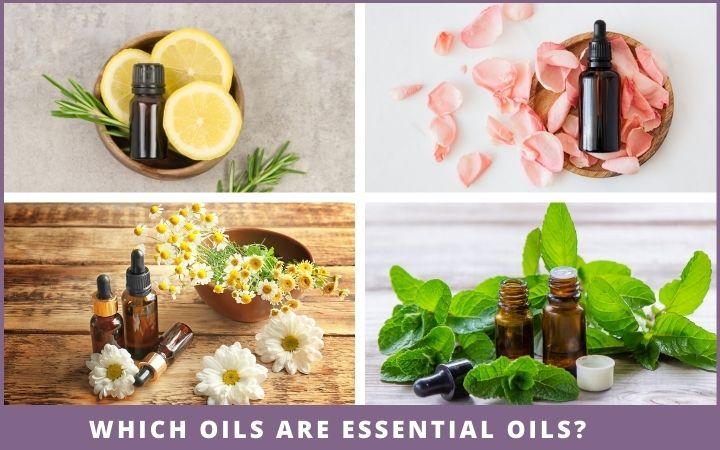 Some of the most popular essential oils include:
Some of the most popular essential oils include:
Lavender: Known for its calming and relaxing properties, lavender essential oil is often used to help alleviate stress, anxiety, and sleep issues.
Peppermint: Peppermint essential oil is renowned for its invigorating and cooling effects, making it a popular choice for relieving headaches, soothing muscle pain, and improving mental focus.
Eucalyptus: With its refreshing and clearing properties, eucalyptus essential oil is commonly used to support respiratory health and alleviate congestion.
Tea Tree: Recognized for its antimicrobial and anti-inflammatory properties, tea tree essential oil is frequently used in skincare products to address acne, dandruff, and minor skin irritations.
Which Oils Are Carrier Oils?
 There are numerous carrier oils available, each with its own unique properties and benefits. Some of the best carrier oils for essential oils include:
There are numerous carrier oils available, each with its own unique properties and benefits. Some of the best carrier oils for essential oils include:
Coconut Oil: Rich in medium-chain fatty acids and antioxidants, coconut oil is an excellent choice for moisturizing and protecting the skin. It also has antimicrobial properties, making it great for use in skincare formulations.
Olive Oil: Packed with vitamins E and K, as well as antioxidants and healthy fats, olive oil is an excellent choice for nourishing and hydrating the skin.
Jojoba Oil: Closely resembling the skin’s natural sebum, jojoba oil is a versatile carrier oil that can help regulate oil production, making it suitable for all skin types.
Almond Oil: High in vitamins A and E, as well as fatty acids, almond oil is an effective moisturizer and skin soother, ideal for use on dry or sensitive skin.
Related: What are Carrier Oils for Essential Oils? + Best Oils & How to Use
How To Use Essential Oils With Carrier Oils
 Essential oils and carrier oils work together in harmony to provide numerous benefits for health, wellness, and skincare. By diluting essential oils with carrier oils, not only is their concentration reduced for safe application on the skin, but their absorption is also enhanced.
Essential oils and carrier oils work together in harmony to provide numerous benefits for health, wellness, and skincare. By diluting essential oils with carrier oils, not only is their concentration reduced for safe application on the skin, but their absorption is also enhanced.
Use these three tips to make the most of the essential oils vs. carrier oils partnership:
1. Choose the right essential oil for your needs and dilute it in a carrier oil to create a safe, skin-friendly blend. A general rule of thumb is to use 2-3% essential oil to carrier oil for most applications.
2. Mix the oils well and apply the blend to your skin for massages.
3. Experiment with different carrier oils to see which one suits your skin type and personal preferences best.
Carrier Oil Dilution Ratio For Essential Oils
 Diluting essential oils in carrier oils is crucial for safe topical application.
Diluting essential oils in carrier oils is crucial for safe topical application.
While there is no one-size-fits-all dilution ratio, a general guideline is to use a 2-5% dilution for most applications. This equates to 12 – 30 drops of essential oil per ounce of carrier oil.
Plant Therapy has a very useful Essential Oil Dilution Chart Magnet. Stick this on your refrigeration so you always have it handy for all your DIY skincare projects.
This ultimate guide to diluting essential oils includes more detailed information about dilution ratios for different applications and important precautions to be aware of.
For more sensitive skin or specific concerns, consult a professional aromatherapist or healthcare provider for guidance.
Can I Use Essential Oils Without Carrier Oils?
 ‘Can I use essential oils without carrier oils?’ That’s a question that comes up every so often so I thought I should answer in a way that leaves no room for ambiguity.
‘Can I use essential oils without carrier oils?’ That’s a question that comes up every so often so I thought I should answer in a way that leaves no room for ambiguity.
You absolutely must mix essential oils with carrier oils for topical applications. This includes when using essential oils for a massage or in DIY skincare or lip-care products such as body butters, lip balms, salves, and roll-ons.
Never apply any essential oil directly on your skin without diluting first diluting with a carrier oil. Essential oils are very concentrated and are likely to cause itching or skin rash. This essential oil safety guide highlights this caution along with other tips for using essential oils safely.
The only time you can use essential oils without carrier oils is when adding to a diffuser. In fact, you should never add carrier oil in a diffuser. It will damage the mechanism. Read more about how to use an essential oil diffuser the right way.
The Upshot: Essential Oils vs. Carrier Oils
Both essential oils and carrier oils offer a wealth of benefits for health, wellness, and skincare.
Essential oils provide concentrated, aromatic extracts with therapeutic properties, while carrier oils deliver nourishing vitamins, minerals, and fatty acids that moisturize and protect the skin.
By understanding their unique properties, uses, and most importantly, the differences between essential oils and carrier oils and how to effectively combine them, you can unlock the full potential of these powerful plant-based oils.
Related: Best pulse points for applying essential oils
Disclaimer: This information is not intended to serve as medical advice. Please consult your physician before using essential oils. See Full Disclaimer here.





